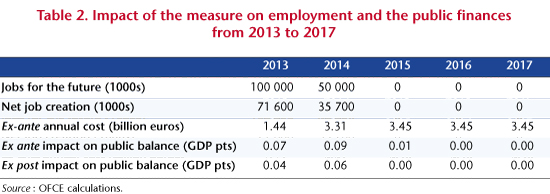The bill aimed at creating 150,000 “jobs for the future” [emplois d’avenir] for unemployed youth will be submitted to Parliament in October 2012. These 150,000 “jobs for the future” are to be reserved primarily for young people from deprived areas. What will be the net impact on employment and public finances?
These full-time jobs, which are planned to last a maximum of five years and are paid at least the minimum wage (SMIC), will be 75% funded by the State, with the rest of the cost being borne by local authorities, associations, foundations and business. According to the Minister of Labour and Employment, Michel Sapin, the goal is to create 100,000 jobs starting in 2013.
The ex-ante cost of the measure
The gross annual cost of a “jobs for the future” contract paid at the SMIC on the basis of a 35-hour full-time week is 24,807 euros. The cost per job for the public finances is 12,831 euros for 75% of the gross wage and 4,807 euros for the exemption from employer social contributions. To this should be added the remaining cost for the employer, or 7,276 euros, when the employer is not a public entity. Based on the assumption that two-thirds of the “jobs for the future” created would be in the non-market sector and one-third in the market sector, the total average annual cost for the public finances therefore comes to 23,015 euros per contract. When fully implemented, the cost of creating 150,000 “jobs for the future” is estimated at 3.45 billion euros a year.
The impact of the measure
By assuming the creation of 100,000 subsidized jobs in the non-market sector and 50,000 in the market sector, the impact would be as follows:
With relatively weak deadweight and substitution effects in the non-market sector (20% according to Fontaine and Malherbet, 2012), 100,000 “jobs for the future” would lead to the net creation of 80,000 jobs over the presidential term. The ex-ante annual cost to the public finances for 100,000 “jobs for the future” in the non-market sector would be 0.12 GDP point, but ex post this would be only 0.07 GDP point because of the extra income – and thus tax and social security revenue – generated by the jobs created.
The state aid (75% of the gross salary) allows a reduction in the cost of labour of 52% at the SMIC level, i.e. a total reduction of 71% of the actual cost of a minimum wage job if one includes the reductions in charges. With the impact of employment elasticities at a maximum labour cost at the level of the SMIC (1.2 according to a DGTPE study in 2007), the 50,000 “jobs of the future” in the market sector would generate 27,300 jobs. The ex-ante cost to the public finances would be 0.05 GDP point, and 0.03 GDP point ex post.
Ultimately, the measure would eventually create 107,300 jobs (about 25% of these in the market sector), i.e. an annual net creation of 72%. The ex-ante cost for the public finances would be 0.17 GDP point, but the ex-post impact of the measure on the public balance would be only -0.1 GDP point because of the extra tax and social security revenue generated by the jobs created and the consequent income gains (Table 1).
According to statements by the Minister of Labour and Employment, two-thirds of the “jobs for the future” will be set up in 2013. To assess the impact of this measure over the presidential term, we started from the assumption that 25,000 full-time “jobs for the future” with a term of 5 years would be created each quarter from the beginning of 2013 until mid-2014.
Based on this profile for the implementation of the “jobs for the future”, the net new job creation expected in 2013 would be 71,600, with 35,700 in 2014, and then 0 from 2015 to 2017. The ex-post impact on the public balance would be 0.04 GDP point in 2013 and 0.06 point in 2014, i.e. a cumulative impact on the public finances of 0.1 GDP point over time.
Bibliography
DGTPE, 2007, Appendices: “Évaluation macroéconomique de la TVA sociale”, in TVA sociale, under the direction of Éric Besson, September.
Fontaine F. and F. Malherbet, 2012, “Les effets macroéconomiques du Contrat unique d’insertion”, LIEPP policy brief, No. 2.
Fougère D., 2007, “Faut-il encore évaluer les dispositifs d’emplois aidés ?”, Économie et Statistique, vol. 408-409.

